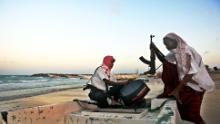
A small Iranian fishing boat was hijacked off the coast of Somalia Tuesday, a local mayor reported.
The boat would be used as a "mother ship" by its captors to launch further attacks, Ali Shire, mayor of the town of Haabo, told Reuters.
The attack is the latest in a series of hijackings in the designated High Risk Area (HRA) off Somalia since the Aris-13 tanker was taken on March 13.
The
region had seen a steady decline in piracy over recent years, after
gaining notoriety for the frequency of attacks around the turn of the
decade. In 2010, Somali pirates hijacked 49 ships and took over 1,000
hostages, according to the International Maritime Bureau.
There are mounting concerns that the period of relative calm may be over, and the threat from piracy could increase further.
Evolving threat
A recent report from the NGO Oceans Beyond Piracy (OBP) found that piracy is spreading and evolving.
Beyond
the HRA, attacks surged off the West Coast of Africa with 95 incidents
in 2016, up from 54 in 2015. The majority took place in Nigerian waters.
The
report also noted a sharp rise in kidnap for ransom attacks in the
region, with 96 hostages taken compared with 44 the previous year, but
just a single instance of hijacking for cargo. Economic losses through
piracy in West Africa increased by more than 10 percent to $793.7
million.
"The
increase in kidnap and ransom attacks is troubling as they tend to
entail greater violence," said report co-author Maisie Pigeon.
"They involve less risk to the pirates themselves and can produce lucrative returns."
Kidnap attacks also increased in Asia, where pirates took 67 hostages and killed six seafarers in 2016.
The
Somali coast was relatively quiet last year, with no successful
hijackings. But the report noted that the vigilance of vessels in the
area had decreased, which Pigeon believes played a part in the spate of
attacks in 2017.
"The
perception of risk to shipping decreased, which gave pirate groups the
opportunity to commit attacks," she says. "In East Africa, the intent
and capability to attack has never gone away. Now we're seeing
opportunities return."
Dropping guard
Piracy authorities are concerned that the threat is escalating.
"What
looked like one-off attacks on vessels is now looking more like a
concerted and organized effort to attack shipping," says Alan Cole, head
of Global Maritime Crime at the UN Office on Drugs and Crime.
Cole believes that carelessness has stoked the threat, with vessels failing to adhere to the best practices document BMP4, issued by a group of leading maritime authorities.
BMP4
encourages vessels to register with the Maritime Security Centre Horn
of Africa (MSCHOA) before entering the HRA, to report to a military
liaison daily while in the area, and to implement protection measures
such as lookouts and physical barriers to boarding.
The
document also carries guidance for routes and speed, such as remaining
within the International Recommended Transit Corridor (IRTC) that is
protected by military support vessels from the European Union Naval
Force (EU NAVFOR) and NATO.
The case of Aris-13, taken by pirates on 13 March near the Yemeni island of Socotra, highlights the need for such measures.
"The
Aris-13 is a little oil tanker that was hijacked while cutting corners
through a no-go area," says Chris Farrell, communications director of
private security group Neptune Maritime Security. "(The ship) had a low
freeboard, no armed guards, no razor wire and no deterrent."
Farrell
says that just 77 percent of ships used the protected IRTC route last
year, and 34 percent used armed guards -- significantly lower figures
than previous years.
Deeper issues
There
is broad agreement among piracy experts that complacency has
contributed to the current surge. But adhering to BMP4 alone is unlikely
to resolve the issue long term.
Farrell
points to a lack of co-ordination between naval fleets and security
forces such as EU NAVFOR, which have a range of remits and priorities
including prevention of drug smuggling and people trafficking.
He adds that pirates often receive light sentences for their crimes, which have little deterrence value.
Dr.
Afyare Elmi, a political scientist at Qatar University who has
published several papers on piracy, believes that conditions on land
must be addressed.
"We
have been relying on offshore containment, but the best way to combat
piracy is through onshore solutions," he says. "The best way is to
invest in the national government, to build capacity at national level."
A
strong Somali government would be able to maintain effective policing
and coast guard services, he argues, and implement new counter piracy
legislation. Such a government could also be a valuable partner for
international bodies, which have limited co-ordination with the current
regime that is seen as weak and ineffective.
Such
longstanding, deep-rooted issues will not be easily resolved. But if
the current wave of piracy continues, it could focus minds on Somalia's
plight.


0 comments: